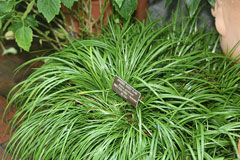 |
|
http://www.flickr.com/photos/28567825@N03 |
 |
|
Translate this page:
Summary
Bloom Color: Green.
Main Bloom Time: Early summer, Late summer, Mid summer. Form: Rounded.
Physical Characteristics

 Acorus gramineus is an evergreen Perennial growing to 0.3 m (1ft) by 0.2 m (0ft 8in).
Acorus gramineus is an evergreen Perennial growing to 0.3 m (1ft) by 0.2 m (0ft 8in).
See above for USDA hardiness. It is hardy to UK zone 5 and is not frost tender. It is in leaf all year, in flower from June to July, and the seeds ripen from July to August. The species is hermaphrodite (has both male and female organs) and is pollinated by Insects.
Suitable for: light (sandy), medium (loamy) and heavy (clay) soils. Suitable pH: mildly acid, neutral and basic (mildly alkaline) soils. It cannot grow in the shade. It prefers moist or wet soil and can grow in water.
UK Hardiness Map
US Hardiness Map
Synonyms
Plant Habitats
Ground Cover; Pond; Bog Garden;
Edible Uses
Edible Parts: Root
Edible Uses: Condiment
Root - raw or cooked[105, 177]. It should be peeled, finely chopped and soaked in several changes of water first[183]. A stronger and more pleasing taste than A. calamus[2, 183]. The root is also used as a ginger substitute[177]. Some caution is advised, see the notes above on toxicity.
References More on Edible Uses
Medicinal Uses
Plants For A Future can not take any responsibility for any adverse effects from the use of plants. Always seek advice from a professional before using a plant medicinally.
Anodyne Antibacterial Antifungal Antiperiodic Antirheumatic Antispasmodic Aromatic Cardiac
Carminative Diaphoretic Diuretic Emmenagogue Epilepsy Expectorant Febrifuge
Parasiticide Sedative Stimulant Stomachic Tonic Vermifuge
The root is antifungal, antibacterial, antiperiodic, antirheumatic, antispasmodic, aromatic, cardiac, carminative, diaphoretic, emmenaggue, febrifuge, sedative, stimulant, stomachic, tonic and vermifuge[4, 7, 9, 21, 61, 147, 165, 176, 178, 218, 238, 240, 279]. It is also powdered and applied to bleeding gums[218, 238]. It is used internally in the treatment of digestive problems - particularly gastralgia and diarrhoea[283], cough, bronchial asthma, neurasthenia, depression, epilepsy etc[176, 238, 283]. Externally, it is used to treat body parasites, dermatosis and haemorrhoids[283]. The root can be harvested at any time of the year, except when the plant is in flower[238]. The root contains an essential oil consisting of asarone and asaryl aldehyde, plus a bitter glucoside acorin[176, 283]. Asarone increases the hypnotic effect of barbiturates and ethanol, lowers blood pressure and is antibacterial against Staphylococcus aureus, streptococci and mycobacterium[176]. The whole plant is anodyne, antiperiodic, antispasmodic, digestive, diaphoretic, diuretic, expectorant, sedative, stimulant, stomachic, sudorific, tonic, vermifuge[218].
References More on Medicinal Uses
The Bookshop: Edible Plant Books
Our Latest books on Perennial Plants For Food Forests and Permaculture Gardens in paperback or digital formats.

Edible Tropical Plants
Food Forest Plants for Hotter Conditions: 250+ Plants For Tropical Food Forests & Permaculture Gardens.
More

Edible Temperate Plants
Plants for Your Food Forest: 500 Plants for Temperate Food Forests & Permaculture Gardens.
More

More Books
PFAF have eight books available in paperback and digital formats. Browse the shop for more information.
Shop Now
Other Uses
References More on Other Uses
Cultivation details
Landscape Uses:Container, Foundation, Ground cover, Massing, Rock garden, Seashore. Grows well in shallow water margins of ponds etc[1, 2], though it can also succeeds in drier habitats[56]. Requires a sunny position[200]. A very ornamental plant, there are some named varieties[208, 238]. The cultivar 'Pusillus' can be grown as a submerged aquatic plant[238]. Special Features:Attractive foliage, Fragrant foliage, Not North American native, Naturalizing, Wetlands plant, Inconspicuous flowers or blooms.
References Carbon Farming Information and Carbon Sequestration Information
Temperature Converter
Type a value in the Celsius field to convert the value to Fahrenheit:
Fahrenheit:
The PFAF Bookshop
Plants For A Future have a number of books available in paperback and digital form. Book titles include Edible Plants, Edible Perennials, Edible Trees,Edible Shrubs, Woodland Gardening, and Temperate Food Forest Plants. Our new book is Food Forest Plants For Hotter Conditions (Tropical and Sub-Tropical).
Shop Now
Plant Propagation
Seed - best sown in a cold frame as soon as it is ripe. Stand the pot in about 3cm of water. Pot up young seedlings as soon as they are large enough to handle, keep them wet by standing the pots in shallow water and overwinter for the first year in a greenhouse or cold frame. Division in spring just before growth starts[1]. Very easy, the plants can be divided at any time in the growing season and can be planted direct into their permanent positions[K].
Other Names
If available other names are mentioned here
Native Range
TEMPERATE ASIA: China (Zhejiang Sheng, Hunan Sheng, Hubei Sheng, Gansu Sheng, Jiangxi Sheng, Guangdong Sheng, Guizhou Sheng, Shaanxi Sheng, Sichuan Sheng, Yunnan Sheng, Guangxi Zhuangzu Zizhiqu, Xizang Zizhiqu), Japan (Honshu, Kyushu, Ryukyu Islands, Shikoku), Korea, South, Taiwan TROPICAL ASIA: India (Sikkim), Myanmar (north), Philippines (Luzon)
Weed Potential
Right plant wrong place. We are currently updating this section.
Please note that a plant may be invasive in one area but may not in your area so it's worth checking.
Conservation Status
IUCN Red List of Threatened Plants Status :

Growth: S = slow M = medium F = fast. Soil: L = light (sandy) M = medium H = heavy (clay). pH: A = acid N = neutral B = basic (alkaline). Shade: F = full shade S = semi-shade N = no shade. Moisture: D = dry M = Moist We = wet Wa = water.
Now available:
Food Forest Plants for Mediterranean Conditions
350+ Perennial Plants For Mediterranean and Drier Food Forests and Permaculture Gardens.
[Paperback and eBook]
This is the third in Plants For A Future's series of plant guides for food forests tailored to
specific climate zones. Following volumes on temperate and tropical ecosystems, this book focuses
on species suited to Mediterranean conditions—regions with hot, dry summers and cool, wet winters,
often facing the added challenge of climate change.
Read More
Expert comment
Author
Sol. ex Aiton.
Botanical References
58200
Links / References
For a list of references used on this page please go here
Readers comment
| Add a comment |
|
If you have important information about this plant that may help other users please add a comment or link below. Only comments or links that are felt to be directly relevant to a plant will be included. If you think a comment/link or information contained on this page is inaccurate or misleading we would welcome your feedback at [email protected]. If you have questions about a plant please use the Forum on this website as we do not have the resources to answer questions ourselves.
* Please note: the comments by website users are not necessarily those held by PFAF and may give misleading or inaccurate information.
To leave a comment please Register or login here All comments need to be approved so will not appear immediately.
|
Subject : Acorus gramineus
|
|
|
|